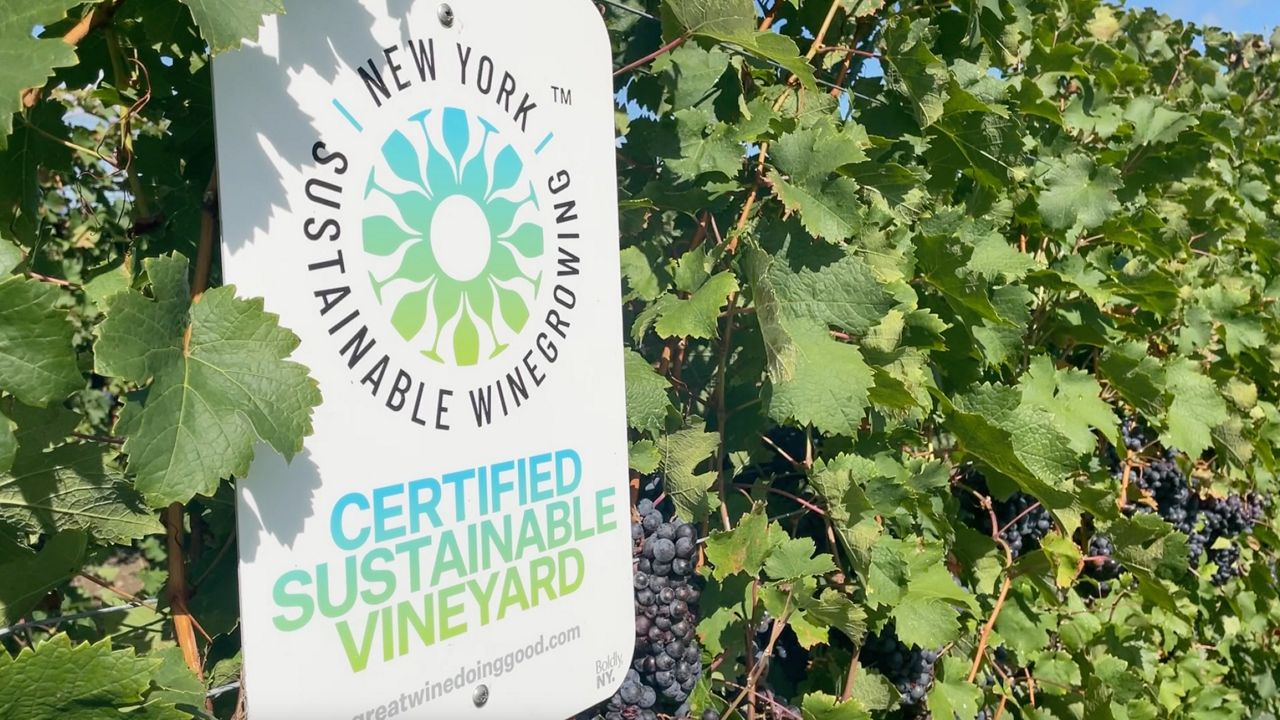Bussiness
N.Y. vineyards participating in new Sustainable Winegrowing Trustmark program

ROCHESTER, N.Y. — Over 100 years in business, it’s fair to say some things have changed. As the world moved more towards renewing, reusing and recycling, so have New York state vineyards.
“I’m a fourth-generation grape grower,” said John Wagner, a co-owner of Wagner Vineyards.
His family’s land, as much as its product, have aged like fine wine in the Finger Lakes region.
“For us, we are 100% estate bottled. So, the wine that we produce is from the grapes that we grow. So it’s kind of showing what we can do on this little slice of land that’s here on the east side of Seneca Lake,” Wagner said.
Last month, the vineyard added a new bottle to its shelves.
“This wine is very special because it is the first wine we release that has the New York Sustainable Winegrowing Trustmark on the bottle. And that’s a program that we’ve been a major part of, had a lot of insight into the process of this trust. [The] mark coming out and we are a certified sustainable vineyard,” said Alex Jankowski, the communications director at Wagner Vineyards.
For the past year, Wagner has been a part of a New York committee of a dozen or so other grape growers, re-writing how sustainability on the vineyards can look across the state.
“We had a great group that was growers and processors throughout New York state. Big growers, small growers all through different regions of the state,” Wagner explained. “Some people from up north, some people from Hudson Valley, Long Island, Western New York, quite a few here from the Finger Lakes, and just hearing how things differ, different, different soil, on Long Island. Sandy stuff out there. So they may do things a little different than ours. They’re flat. We’re sloped. So that brings in a whole host of other things that we have to keep in consideration.”
The committee created the New York Sustainable Winegrowing Trustmark with dozens of rules vineyards across the state can conform to in order to be a sustainable vineyard.
“This is the same cabernet franc that we harvest for the rosé. So the same wine that currently bears our sustainable vineyard trustmark is being grown right in front of us,” Jankowski said.
The vineyard’s cabernet franc is roughly 10 yards from its tasting room for guests to see for themselves. It’s been there for decades since the Wagner family took grape growing measures into their own hands, but previous vintages have officially sold out, so it’s the first time consumers can see how sustainability tastes.
“More and more customers care about, the businesses that they’re going to, understanding what their philosophies are, what their principles might be and understand, really, at the end of the day, what they’re putting in their body,” Jankowski said.
However, the growing strategies are nothing new to the Wagners.
“This is not a crop where we take these vines out every year and plant new vines every year. These vines, we’re looking at vines here that are decades old. And so a sustainable vineyard is going to be able to utilize those same vines year over year,” Jankowski explained. “We have trunks of varying ages that every time one starts to get a little bit older, we bring what’s called a renewal up. And we start to train that on our training system.”
The farmers renew their vines about every five years, but they perform what’s known as de-hilling every year. That’s a strategy in which farmers move the deeper soil to the top in order to preserve its nutrients for the vines and reduce soil replacement efforts, which they say is sustainable for the environment, as well as the financial standpoint.
“We’re hilling and de-hilling every year, that process happens every year. The trunk renewal about every five years,” Jankowski said.
Another sustainable effort on the farm over the past few decades has been adding more grass in between each row of vines. Pictures of Wagner Vineyards from the 1970s look much more brown in between rows.
As rain has come in similar amounts throughout the years, Jankowski says each year, rain seems to be coming down in smaller time frames. The fescues next to each vine help prevent an excess of water from getting to the grapes prematurely.
“What you have down here are a lot of low-lying grasses and fescue,” he explained. “Helps with weed suppression. Helps with moisture retention as well.”
Jankowski refers to the sustainability guidelines as a rubric with a particular grading strategy. This allows the vineyards to excel in some sustainability measures more than others, but still not qualify for the sustainability trustmark. The committee created a very particular strategy to ensure all sustainability measures are being taken to preserve New York land.
“Understanding your land specifically for where you are. And that’s something where, you know, for us, being a fifth-generation grape [grower] over 100 years, that we can look back on, 100 years of experience, 100 years of sometimes mistakes, 100 years of successes,” Jankowski said. “I think, you know, taking pride not just in being a family-owned and operated business, but being able to show steps that we’ve taken over the decades, over the generations where we’re really putting the health of our soil first and understanding that that is going to, in and of itself, lead to great grapes, which then leads to great wine as well. You know, get wine really does start in the vineyard.”
Wagner’s Vineyards consists of 240 acres of land that’s growing not only its grapes sustainability, but as an estate vineyard, they’re able to sell much of their crop to other vineyards as well. That means the Sustainable Winegrowing Trustmark will become much more common in the Finger Lakes region and beyond in the coming years.
“We’ve got to keep doing things better and thinking about clean air and clean water. And these lakes are precious. That’s the reason that we can grow grapes here on the east side of Seneca Lake; we’ve got the moderating effect of this lake. And we really got to preserve the clean water, clean air, everything we can,” Wagner said.










